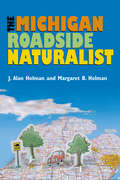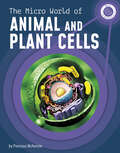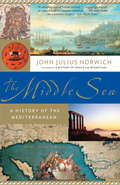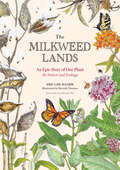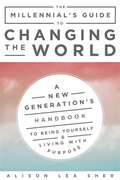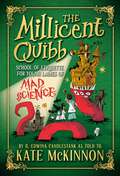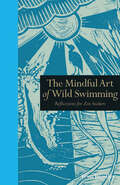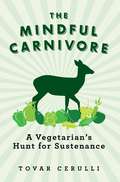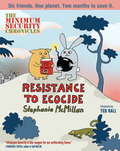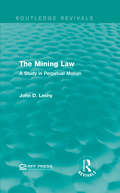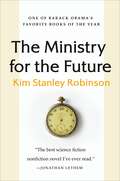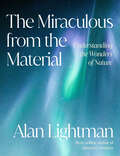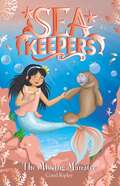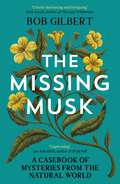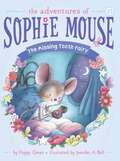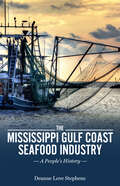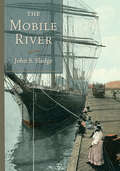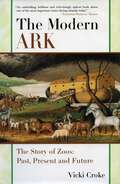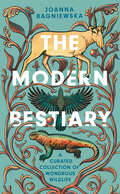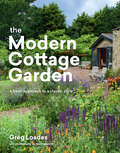- Table View
- List View
The Michigan Roadside Naturalist
by J. Alan Holman Margaret B. HolmanDid you know . . . ? * Michigan is seventeenth in oil production in the United States. * The Great Lakes are said to be the only glacially produced structures that can be seen from the moon. * Michigan was once part of a coral reef. * The wood frog is one of the commonest true frogs of moist woodland floors in Michigan today and is able to freeze solid during the winter without harmful effects. These and many more amazing facts await the curious traveler in The Michigan Roadside Naturalist, J. Alan and Margaret B. Holman's captivating guide to the natural treasures of Michigan. A perfect accompaniment to the classic Michigan Trees and The Forests of Michigan, this user-friendly guide offers a Who's Who of the geology, biology, and archaeology of the Great Lakes State, as well as highway adventures along the state's major routes. The book begins with an educational yet accessible tour of important points in Michigan's natural and archaeological history, followed by seven road trips based on commonly traveled state routes, moving from south to north in the Lower Peninsula and east to west in the Upper Peninsula. Readers can proceed directly to the road trips or familiarize themselves with the state's treasure trove of fascinating features before embarking. Either way, an informative and fun odyssey awaits the passionate naturalist, amateur or otherwise.
The Micro World of Animal and Plant Cells (Micro Science)
by Precious McKenzieA tree and your pet look nothing alike, but they have one thing in common—they are both made up of cells. Cells are really small. You can see them only with a microscope. Young readers will find out about the parts of cells, how they work, and what the differences are between animal and plant cells.
The Middle Sea: A History of the Mediterranean
by John Julius NorwichThis lively and dramatic book brings roaring to life the grand sweep of 5,000 years of history in the cradle of civilization. A wonderfully illustrated account of the civilizations that rose and fell on the lands bordering the Mediterranean, The Middle Sea represents the culmination of a great historian's unparalleled art and scholarship. John Julius Norwich provides brilliant portraits of the Phoenicians, the Egyptians, the Greeks, the Romans, the Byzantines, the Arabs, the French, the Venetians, the Popes, and the pirates of the Gulf. Above all, he deftly traces the intermingling of ancient conflicts and modern sensibilities that shapes life today on the shores of the Middle Sea. (From the Trade Paperback edition.)
The Mighty Mississippi (Into Reading, Level I #8)
by Patricia KummerNIMAC-sourced textbook <p><p> The Mississippi is a mighty river. Read this book to find out all about it.
The Milkweed Lands: An Epic Story of One Plant: Its Nature and Ecology
by Eric Lee-MäderDelve into this fascinating appreciation of milkweed, an often-overlooked plant, and discover an amazing range of insects and organisms that depend on it as the seasons unfold, with this collaboration between a noted ecologist and an award-winning botanical illustrator. Ecologist Eric Lee-Mäder and noted botanical artist Beverly Duncan have teamed up to create this unique exploration of the complex ecosystem that is supported by the remarkable milkweed plant, often over-looked or dismissed as a roadside weed. With stunning, up-close illustrations and engaging text, they trace every stage of the plant's changes and evolutions throughout the seasons, including germination, growth, flowering, and seed development. Simultaneously, they chronicle the lives of the many creatures whose lives are intertwined with the milkweed: monarch butterflies; soldier and queen butterflies; milkweed tussock moths; large and small milkweed bugs; milkweed weevils; bumble bees; goldfinches; and more. The delightful illustrations and illuminating text give the reader the feeling of browsing an avid naturalist's sketchbook, while also learning about different milkweed species, how to propagate milkweed in the garden, the industrial uses of milkweed, interesting milkweed relatives, and more. This publication conforms to the EPUB Accessibility specification at WCAG 2.0 Level AA.
The Millennial's Guide to Changing the World: A New Generation's Handbook to Being Yourself and Living with Purpose
by Alison Lea SherA guide and blueprint to a purposeful millennial existence—and how we can make a difference. What does it mean to be a millennial in this chaotic world? Beyond Snapchat and Tinder, the consumerist culture we’ve inherited, and quarter-life crises, can a millennial aspire to more? Alison Lea Sher argues, yes, we can! Packing herself up in an RV, Sher embarks on a road trip in hopes of starting a conversation about what it means to grow up in America, post-Great Recession. Interviewing 150 of her millennial peers as they begin their adult lives—from kids heading straight to Wall Street after college to those sleeping on it—Sher asks: “Who are you; what should you do; and how can you step into your destiny as a stakeholder in society?” The Millennial’s Guide to Changing the World is a one-of-a-kind ethnographic study on the spotlighted millennial generation, as told by millennials—the largest generation in US history that is now transitioning from adolescence to adulthood. As millennials embark on a young adult quest during a frightening time, how can they enlist the idealism, values, and resistance politics they are so well-known for to discover a sense of self and purpose? Learn how to: “Adult”—and not in the way society defines itRide the technology revolution, instead of letting it ride youBe ethical, inclusive, and sex-positive in your relationshipsResist the corporate oligarchy we live inRecognize privilege, embrace diversity, and fight for equalitySave the earth, literally With intimate stories, ethnographic research, and practical tips, The Millennial’s Guide to Changing the World will inspire every young person, showing them how to optimize their coming-of-age potential in a world that desperately needs it.
The Millicent Quibb School of Etiquette for Young Ladies of Mad Science (The Millicent Quibb School of Etiquette for Young Ladies of Mad Science #1)
by Kate McKinnonA #1 New York Times bestseller! From beloved Saturday Night Live alum Kate McKinnon comes a madcap new adventure about three sisters, a ravenous worm, and a mysterious mad scientist! So, you want to be a young mad scientist. Congratulations! Admitting it is the first step. The second step is reading the (definitely true) tale of the Porch sisters… Gertrude, Eugenia, and Dee-Dee Porch do not belong. They don&’t belong in the snooty town of Antiquarium, where all girls have to go to etiquette school and the only dog allowed is the bichon frise. They don&’t belong with their adoptive family, where all their cousins are named Lavinia and their Aunt has more brooches than books. And they certainly don&’t belong at Mrs. Wintermacher&’s etiquette school—they&’re far more interested in science. After getting kicked out of the last etiquette school that would take them, the girls expect to be sent away for good... until they receive a mysterious invitation to new school. Suddenly the girls are under the tutelage of the infamous Millicent Quibb—a mad scientist with worms in her hair and oysters in her bathtub. At 231 Mysterium Way, the pizza is fatal, the bus is powered by Gerbils, and the Dean of Students is a hermit crab. Dangerous? Yes! More fun than they&’ve ever had? Absolutely! But when the sisters are asked to save their town from an evil cabal of nefarious mad scientists, they must learn to embrace what has always made them stand out, and determine what side they&’re on—before it&’s too late!
The Mindful Art of Wild Swimming: Reflections for Zen Seekers (Mindfulness Ser.)
by Tessa Wardley“Turn your outdoor bathing into an enriching meditation with this exploration into the emotional benefits of swimming in nature.” —Health & FitnessThe Mindful Art of Wild Swimming explores how swimming in rivers, lakes, and seas is the very epitome of conscious living. Zen-seeker Tessa Wardley reconnects the physical and spiritual cycles of life to the changing seasons and flow of wild waters worldwide and leads the reader on to a mindful journey through the natural world. Combining expert insight and personal anecdote, she shares with sparkling clarity why our relationship with open water is so fundamental to pure wellbeing, and reveals how wild swimming can be the ultimate Zen meditation.“Tessa Wardley is a keen and knowledgeable guide” —Times Literary Supplement
The Mindful Carnivore: A Vegetarian's Hunt for Sustenance
by Tovar CerulliA vegan-turned-hunter reignites the connection between humans and our food sources and continues the dialog begun by Michael Pollan and Barbara Kingsolver. While still in high school, Tovar Cerulli experimented with vegetarianism and by the age of twenty, he was a vegan. Ten years later, in the face of declining health, he would find himself picking up a rifle and heading into the woods. Through his personal quest, Tovar Cerulli bridges disparate worldviews and questions moral certainties, challenging both the behavior of many hunters and the illusion of blamelessness maintained by many vegetarians. In this time of intensifying concern over ecological degradation, how do we make peace with the fact that, even in growing organic vegetables, life is sustained by death? Drawing on personal anecdotes, philosophy, history and religion, Cerulli shows how America's overly sanitized habits of consumption and disconnection with our food have resulted in so many of the health and environmental crises we now face.
The Minimum Security Chronicles
by Stephanie McmillanFrom the winner of the 2012 Robert F. Kennedy Journalism Award, a character-driven tale about our threatened environment and the practicality of putting contemporary revolutionary strategy into action. In The Minimum Security Chronicles, the latest long-form narrative from Robert F. Kennedy Journalism Award-winning cartoonist Stephanie McMillan, lifelong friends Kranti and Bananabelle are rounded up during a protest and locked in a pen by a faraway railroad track. After their escape, when trying to gain proof of their capture, Kranti discovers the future site of a nuclear power plant. After attempting to shut it down, she learns of an even more ecologically dangerous enterprise: a massive geo-engineering project scheduled to begin in a matter of weeks. And so begins the tale of a group of friends--among them an apolitical computer programmer, an aspiring musician who joins the Occupy movement, a lovestruck community gardener, a militant bunny and a guinea pig theorist--who try to halt the plans of evil corporate overlords bent on destroying the earth for profit.From the Trade Paperback edition.
The Mining Law: A Study in Perpetual Motion (Routledge Revivals)
by John D. LeshyOriginally published in 1987, John D. Leshy presents this scholarly study of the 1872 Mining Law as a legal treatise and history of mining in the West from the point of view of mineral exploration and production. This mining law governed the United States mining practice yet had never been changed. The Mining Law attempts to highlight the role of policy and government as well as the more obscure elements of the law which complicated mining practice in the eighties. This title will be of interest to students of Environmental Studies and policy makers.
The Ministry for the Future: A Novel
by Kim Stanley RobinsonONE OF BARACK OBAMA&’S FAVORITE BOOKS OF THE YEAR&“The best science-fiction nonfiction novel I&’ve ever read.&” —Jonathan Lethem "If I could get policymakers, and citizens, everywhere to read just one book this year, it would be Kim Stanley Robinson&’s The Ministry for the Future." —Ezra Klein (Vox)The Ministry for the Future is a masterpiece of the imagination, using fictional eyewitness accounts to tell the story of how climate change will affect us all. Its setting is not a desolate, postapocalyptic world, but a future that is almost upon us. Chosen by Barack Obama as one of his favorite books of the year, this extraordinary novel from visionary science fiction writer Kim Stanley Robinson will change the way you think about the climate crisis."One hopes that this book is read widely—that Robinson&’s audience, already large, grows by an order of magnitude. Because the point of his books is to fire the imagination."―New York Review of Books"If there&’s any book that hit me hard this year, it was Kim Stanley Robinson&’s The Ministry for the Future, a sweeping epic about climate change and humanity&’s efforts to try and turn the tide before it&’s too late." ―Polygon (Best of the Year) "Masterly." —New Yorker"[The Ministry for the Future] struck like a mallet hitting a gong, reverberating through the year ... it&’s terrifying, unrelenting, but ultimately hopeful. Robinson is the SF writer of my lifetime, and this stands as some of his best work. It&’s my book of the year." —Locus"Science-fiction visionary Kim Stanley Robinson makes the case for quantitative easing our way out of planetary doom." ―Bloomberg Green
The Miraculous from the Material: Understanding the Wonders of Nature
by Alan LightmanA gorgeously illustrated exploration of the science behind the universe&’s most stunning natural phenomena—from atoms and parameciums to rainbows, snowflakes, spider webs, the rings of Saturn, galaxies, and moreNature is capable of extraordinary phenomena. Standing in awe of those phenomena, we experience a feeling of connection to the cosmos. For acclaimed physicist and novelist Alan Lightman, just as remarkable is that all of what we see around us—soap bubbles, scarlet ibises, shooting stars—are made out of the same material stuff and obey the same rules and laws. This is what Lightman calls &“spiritual materialism,&” the belief that we can embrace spiritual experiences without letting go of our scientific worldview.Pairing 36 beautiful, full-color photos evoking some of nature&’s most awe-inspiring phenomena with accessible and lyrical personal essays, The Miraculous from the Material explores the fascinating science underlying the natural world. Why do rainbows make an arc? Why does a particular waterfall at Yosemite National Park sometimes glow like it&’s on fire? How does a hummingbird fly? The world has so many things to marvel at—and the science is just as fascinating.Lightman&’s imagination travels from the world of atoms and molecules to the animal kingdom, from places like Ha Long Bay, Vietnam and the Grand Canyon out to the solar system and beyond, illuminating the majesty of the cosmos and the remarkable science behind it. The Miraculous from the Material is a stunning, soaring ode to the beauty and wonder around us, and the perfect holiday gift for photography aficionados, life-long learners, and admirers of the natural world.
The Missing Manatee
by Cynthia DefeliceFrom School Library Journal Gr 5-7-It's spring vacation, and Skeet Waters, 11, wants to spend his time fishing in his boat just off the coast of his Florida home. Instead, his day begins with him overhearing his mother telling his father to move out for good. Things go from bad to worse when Skeet finds a manatee floating in the water, dead from a gunshot wound. He goes back to shore to get the sheriff, and when they return to the spot, the animal is gone. The boy makes finding the missing body and bringing the killer to justice his mission. Meanwhile, his father's buddy, Dirty Dan, takes Skeet out fishing for tarpon and drinks Jack Daniels all day. When Skeet discovers a gun in a storage bin, he begins to suspect that Dan is the culprit and confronts him. The man confesses that his special-needs son accidentally shot the animal. DeFelice offers a realistic adventure story that is fast paced and full of drama. Skeet faces many difficult problems throughout the book, each with serious consequences, and his first-person narrative rings true. The characters are multifaceted and well developed, and the story should prompt readers to think about cause and effect.-Alison Grant, West Bloomfield Township Public Library, MI Copyright 2005 Reed Business Information.
The Missing Manatee: Book 9 (Sea Keepers #9)
by Coral RipleySea Keepers to the rescue - a baby manatee needs their help! A magical series about saving our oceans.Emily, Grace and Layla travel to the tropics to search for a magic pearl. But disaster strikes when evil Effluvia kidnaps a baby manatee and holds it for ransom. Effluvia demands a magic pearl in exchange for the little manatee. If the Sea Keepers give into the wicked siren, they won't be able to stop her from releasing her siren sisters . . . It's up to the Sea Keepers to save the manatee - and the whole underwater world!
The Missing Musk: A Casebook of Mysteries from the Natural World
by Bob Gilbert'Utterly fascinating and intriguing' Neil Ansell, author of The Last Wilderness'A captivating dive into the mysteries of nature' Lee Schofield, author of Wild FellIn 1913 all the musk plants in the world stopped smelling. Unable to resist the lure of this mystery, Bob Gilbert turns detective, determined to find the truth in the tale. Mixing history, memoir, science and nature writing, The Missing Musk takes the reader on a journey of discovery, uncovering the truth behind six mysteries and myths from across the natural world.From the darkest corners of Britain's churchyards to Scotland's Pentland Hills, Bob travels the length of the UK, seeking answers to questions that have intrigued him throughout his life. In search of the musk's long-lost fragrance, he discovers a possibly murderous story. Investigating the true origins of 'star jelly' leads to encounters with unexplained sightings and substances. Faced with the urban myth-like stories of mosquitoes thriving in the London Underground, Bob digs deeper.Motivated by the curious, unexplained phenomena found in wild places and on urban streets, Bob peers into microscopes, delves into horticultural archives and chases a glimpse of the strange 'water bear', finding that, when it comes to mysteries, the joy is found as much in the search as in the answer it leads you to . . .
The Missing Musk: A Casebook of Mysteries from the Natural World
by Bob Gilbert'Utterly fascinating and intriguing' Neil Ansell, author of The Last Wilderness'A captivating dive into the mysteries of nature' Lee Schofield, author of Wild FellIn 1913 all the musk plants in the world stopped smelling. Unable to resist the lure of this mystery, Bob Gilbert turns detective, determined to find the truth in the tale. Mixing history, memoir, science and nature writing, The Missing Musk takes the reader on a journey of discovery, uncovering the truth behind six mysteries and myths from across the natural world.From the darkest corners of Britain's churchyards to Scotland's Pentland Hills, Bob travels the length of the UK, seeking answers to questions that have intrigued him throughout his life. In search of the musk's long-lost fragrance, he discovers a possibly murderous story. Investigating the true origins of 'star jelly' leads to encounters with unexplained sightings and substances. Faced with the urban myth-like stories of mosquitoes thriving in the London Underground, Bob digs deeper.Motivated by the curious, unexplained phenomena found in wild places and on urban streets, Bob peers into microscopes, delves into horticultural archives and chases a glimpse of the strange 'water bear', finding that, when it comes to mysteries, the joy is found as much in the search as in the answer it leads you to . . .
The Missing Tooth Fairy (The Adventures of Sophie Mouse #15)
by Poppy GreenSophie gets a visit from the tooth fairy—or does she?—in this fifteenth charming book of The Adventures of Sophie Mouse series!Sophie Mouse has never lost a tooth before. But it looks like that&’s about to change because Sophie&’s tooth sure is wiggly! She&’s a little scared…until a friend tells her that when you lose your tooth and put it under your pillow, the tooth fairy brings you a present! Now Sophie can&’t wait for her tooth to fall out. Then, Sophie does exactly what she&’s supposed to but the tooth fairy never comes! What did Sophie do wrong? Or is the tooth fairy simply…missing? With easy-to-read language and illustrations on almost every page, the Adventures of Sophie Mouse chapter books are perfect for beginning readers.
The Mississippi Gulf Coast Seafood Industry: A People's History (America's Third Coast Series)
by Deanne Love StephensThe seafood industry on the coast of Mississippi has attracted waves of immigrants and other workers—oftentimes folks who were either already acquainted with maritime livelihoods or those who quickly adapted to the resources of the region. For generations the industry has provided employment and sustenance to Coast peoples. Deanne Love Stephens tells their stories and identifies key populations who have worked this harvest. Oyster and shrimp processing were the most significant of these trades, and much of the Gulf Coast's history follows these two delicacies. Harvesting, processing, and marketing oyster and shrimp products built the Mississippi seafood industry and powered the growth of the entire coastal region. This book is the first to offer a broad view of the many ethnic groups and distinct populations who toiled in the oyster and shrimp industries. Relying heavily upon contemporary newspapers, oral histories, and interviews to create a rich picture of the industry and its workers, the author presents the history of laboring people who daily toiled in factories and often went unheard and unrecognized. Stephens provides an overview of significant early developments and the beginnings of the industry, considering the development of railroad expansion, lighthouse construction, and ice technology. She covers significant state and federal legislation that both defined and protected marine resources, illustrating the depth of the industry’s importance as Mississippians wrestled with adequate protective measures to preserve oyster and shrimp resources throughout the nineteenth and twentieth centuries.
The Mitten
by Jan Brett<p>A bestselling modern classic that has been a family favorite for over 25 years. <p>When Nicki drops his white mitten in the snow, he goes on without realizing that it is missing. <p>One by one, woodland animals find it and crawl in; first, a curious mole, then a rabbit, a badger and others, each one larger than the last. Finally, a big brown bear is followed in by a tiny brown mouse and what happens next makes for a wonderfully funny climax. <p>In her distinctive style, Jan Brett brings the animals to life with warmth and humor, and her illustrations are full of visual delights and details faithful to the Ukrainian tradition from which the story comes.</p>
The Mitten
by Jan BrettWhen Nicki drops his white mitten in the snow, he goes on without realizing that it is missing.One by one, woodland animals find it and crawl in; first, a curious mole, then a rabbit, a badger and others, each one larger than the last. Finally, a big brown bear is followed in by a tiny brown mouse and what happens next makes for a wonderfully funny climax.As the story of the animals in the mitten unfolds, the reader can see Nicki in the boarders of each page, walking through the woods unaware of what is going on.Once again Jan Brett has created a dramatic and beautiful picture book in her distinctive style. She brings the animals to life with warmth and humor, and her illustrations are full of visual delights and details faithful to the Ukrainian tradition from which the story comes.
The Mobile River
by John S. Sledge“A fine, fascinating book. John S. Sledge introduces us to four centuries worth of heroes and rogues on one incredible American river.” —Winston Groom, New York Times–bestselling author of Forrest GumpThe Mobile River presents the first-ever narrative history of this important American watercourse. Inspired by the venerable Rivers of America series, John S. Sledge weaves chronological and thematic elements with personal experiences and more than sixty color and black-and-white images for a rich and rewarding read.Previous historians have paid copious attention to the other rivers that make up the Mobile’s basin, but the namesake stream along with its majestic delta and beautiful bay have been strangely neglected. In an attempt to redress the imbalance, Sledge launches this book with a first-person river tour by “haul-ass boat.” Along the way he highlights the four diverse personalities of this short stream—upland hardwood forest, upper swamp, lower swamp, and harbor.In the historical saga that follows, readers learn about colonial forts, international treaties, bloody massacres, and thundering naval battles, as well as what the Mobile River’s inhabitants ate and how they dressed through time. A barge load of colorful characters is introduced, including Native American warriors, French diplomats, British cartographers, Spanish tavern keepers, Creole women, steamboat captains, African slaves, Civil War generals and admirals, Apache prisoners, hydraulic engineers, stevedores, banana importers, Rosie Riveters, and even a few river rats subsisting off the grid—all of them actors in a uniquely American pageant of conflict, struggle, and endless opportunity along a river that gave a city its name.“Sledge brilliantly explores the myriad ways human history has entwined with the Mobile River.” —Gregory A. Waselkov, author of A Conquering Spirit
The Modern Ark: Past, Present, and Future
by Vicki CrokeAn in-depth look at the radical changes occurring in our nation's zoos -- from cement-paved mazes to simulated rain forests to completely natural landscapes -- as well as the history behind the actual idea of the zoo. Following the lead of private menageries in Europe, public zoos began to proliferate throughout America. What once started as symbols of prestige & power are now educational centers, developing advanced technologies in the race to conserve all that remains of the natural world. With DNA fingerprinting, artificial insemination, embryo transfers, & egg harvesting, zoos play a critical role in the fight to save endangered species.
The Modern Bestiary: A Curated Collection of Wondrous Wildlife
by Joanna BagniewskaA quirky collection of Earth&’s most compelling animals who give mythical creatures a run for their moneyThe Modern Bestiary: A Curated Collection of Wondrous Wildlife mirrors the medieval tradition of an encyclopedia of incredible beasts, only this charming book with ornamental illustrations features 100 real animals who are stranger than fiction. Organized by the elements Earth, Water, and Air, the book introduces both unfamiliar creatures, like deep-sea harp sponges who catch prey in their barbs and digest them whole, as well as ones that have made headlines, such as cicadas who emerge from the ground in noisy broods every thirteen or seventeen years. Step right up and meet these delightful, unbelievable, and deliciously horrific animals, including: The endearing:same-sex albatross mothers who raise chicks togethertarantulas who keep frogs as petszebra finches who sing to their eggs to warn them of hot weatherThe ruthless:flukes who manipulate their host into getting eaten by a final hosthorned lizards who squirt blood through their eyes to distract predatorssouthern grasshopper mice who harness scorpion venom as a painkiller And the just plain weird:antechinuses who mate themselves to deathpearlfish who live, fight, and mate in sea cucumber buttsimmortal jellyfish who reverse their aging process when stressed Funny, entertaining, and illuminating, The Modern Bestiary is a book for anyone who wants to become more familiar with the natural world and all its astounding creatures.
The Modern Cottage Garden: A Fresh Approach to a Classic Style
by Greg Loades&“An inspirational book, with encouraging words and down-to earth advice for achieving a year-round beautiful garden.&” —Michael Marriott, chief rosarian at David Austin Roses In this practical and inspirational guide, Greg Loades presents a new style of planting: a fusion between classic cottage style and the new perennial movement. Using real gardens as examples, The Modern Cottage Garden teaches gardeners how to combine the best of both styles—big, colorful blooms and striking grasses and native plants—into one beautiful space that requires little maintenance and has a long season of interest. Fresh planting ideas for containers, small gardens, and diverse climates present an exciting style that can shine anywhere.
